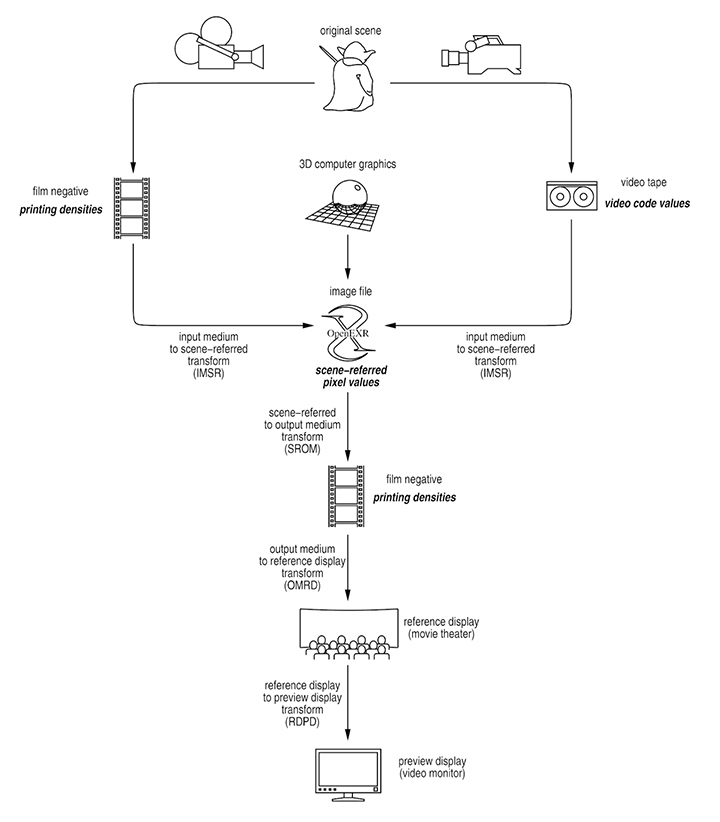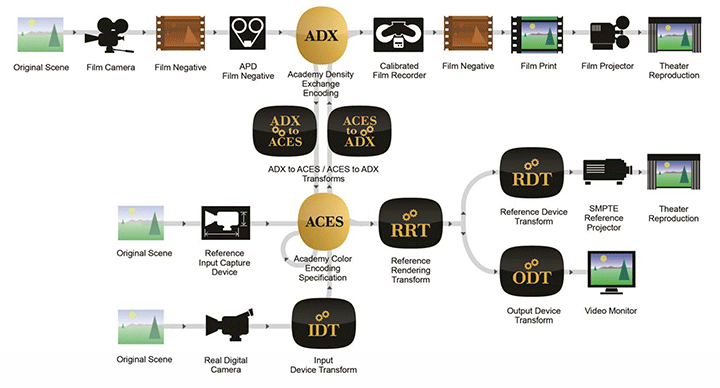Why scene linear workflow now?
The scene linear workflow, which has been implemented in Japan since 2012, is a video production technique that is a condensed version of the know-how cultivated in Hollywood over many years. By adopting the scene linear workflow, it is expected to dramatically improve video quality and at the same time reduce costs by shortening production man-hours, enabling efficient high-quality video production.
Because of its physics-based nature, the scene linear workflow has tremendous power in VFX productions where computer graphics and live action plates are intricately intertwined. At the same time, it has a universality that affects many specialists and their workflows, including cinematographers, DITs, colorists, and editors. Recent examples include the implementation of scene linear/ACES (Academy Color Encoding System) based color management systems in digital cinema cameras, color grading systems, non-linear editing and compositing systems, and CG software.
Color management in video production is a foundational element of the scene linear workflow, and ACES is a framework for a scene linear workflow that includes color management. In this series of articles, after learning the basics of the scene linear workflow/ACES concept, we will discuss in detail the impact of the scene linear workflow on the Japanese video and VFX industry.
Scene Linear Workflow and VFX
At the Birds of a Feather meeting at SIGGRAPH 2004, a session on “OpenEXR, Film and Color” was held. In his presentation “A Proposal for OpenEXR Color Management,” Florian Kainz of Industrial Light & Magic, the meeting organizer, proposed a practical color management system using the OpenEXR format for VFX film production. A practical color management system using the OpenEXR format for VFX video production is proposed in the presentation “A Proposal for OpenEXR Color Management.

Kainz, F. Industrial Light & Magic. SIGGRAPH 2004. p3
In addition to the complex process of combining film scan data, video camera data, SLR RAW data, and computer graphics, VFX films at that time required the process of digital intermediation (DI), in which digital data is printed on the screening film. In this series of processes, color differences between different media, such as film cameras and video cameras used for shooting, and video monitors and film-based projectors for display, become a major problem.
Kainz proposes a specific solution to this problem by converting film and video materials into digital images that represent the light intensity that existed in the actual shooting scene. The complexity of the VFX process is simplified by removing and unifying the characteristics of each media in the process of converting the density values of film read by a scanner or the code values recorded on a videotape into a “Scene-referred Image”. This process based on “Scene-referred” has basic principles in common with the current scene-linear workflow, and was the VFX color pipeline used in practice at Industrial Light & Magic back in 2004. In this series, the digital image that represents the light that existed in the real scene will be referred to as “scene linear,” and the process used to manage the colors and tones of the image for video production will be referred to as the “color pipeline.

Science and Technology Council Academy of Motion Picture Arts and Science. “THE ACADEMY COLOR ENCODING SYSTEM – Idealized System” 2013. *2
This meeting at SIGGRAPH provided an opportunity for the Academy of Motion Picture Arts & Sciences (AMPAS), an organization dedicated to the advancement of the arts and sciences in the motion picture industry, to launch a project in 2004 to create an Academy standard file format, the prototype for the current Academy Color Encoding System (ACES). The following is a summary of the benefits of adopting ACES, which can be found on the current AMPAS website*4.
In post-production, including VFX, the unification of all materials in ACES makes it easy to match different cameras and materials, and to build a reliable color pipeline. Matching of materials becomes easier, and a highly reliable color pipeline can be built. From the aspect of video content management, it is very effective as a multipurpose digital source master for theatrical distribution, Blu-ray, etc., and is also ideal as a standard file format for archival purposes.”
The following is a quote from the “Digital Cinema System Specification v1.0” released in 2005 by “Digital Cinema Initiatives, LLC” (DCI), the core organization for digital cinema standardization based on the seven major motion picture studios in Hollywood (Disney, Paramount Pictures, Sony Pictures Entertainment, etc.). DCI is the core organization for digital cinema standardization based on the seven major film production studios in Hollywood (Disney, Paramount Pictures, Sony Pictures Entertainment, etc.). This document describes in detail the standardization of images and their presentation, including delivery formats, requirements for projection equipment and screening environments. The pre-distribution content format produced in post-production is referred to here as Digital Source Master (DSM). Because of its importance, it is said that the specification of DSM, which is the subject of archiving, is left to the content owner*5.
The advantages of the latest ACES standard regarding content management make it a very effective DSM format for post-production. With the increasing number of productions in the ACES environment, using the scene linear workflow/ACES for video production not only improves the production environment for VFX artists and other specialists, but also plays an important role in the distribution and storage of video content.
1) Kainz, F. Industrial Light & Magic. “A Proposal for OpenEXR Color Management” SIGGRAPH 2004. p1. http://www.openexr.com/OpenEXRColorManagement.pdf
2) Science and Technology Council Academy of Motion Picture Arts and Science. “THE ACADEMY COLOR ENCODING SYSTEM – Idealized System” http://www.oscars.org/science-technology/council/projects/pdf/ACESOverview.pdf
3) Maltz, A. “The Image Interchange Framework Demystified:What it is, and why it matters – A Brief History of IIF” HPA Tech Retreat 2012
4) Academy of Motion Picture Arts and Science. THE ACADEMY COLOR ENCODING SYSTEM. Website. http://www.oscars.org/science-technology/council/projects/aces.html
5) Digital Cinema Initiatives, LLC. “Digital Cinema System Specification v1.0” 2005. p8. http://www.dcimovies.com/archives/spec_v1/DCI_Digital_Cinema_System_Spec_v1.pdf
